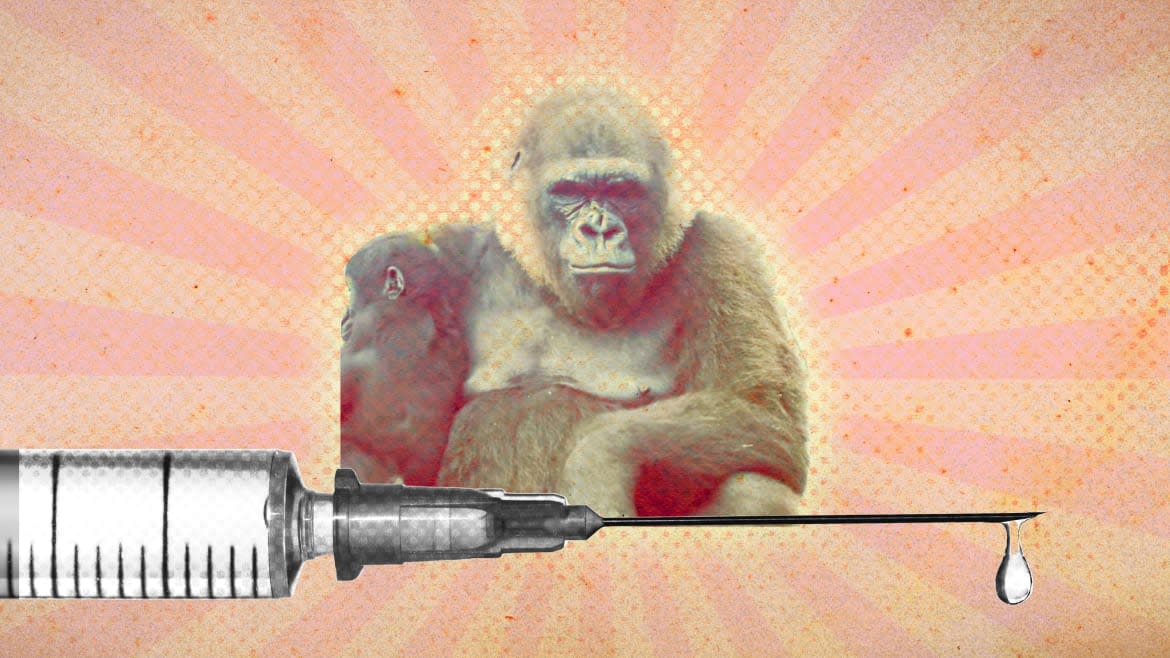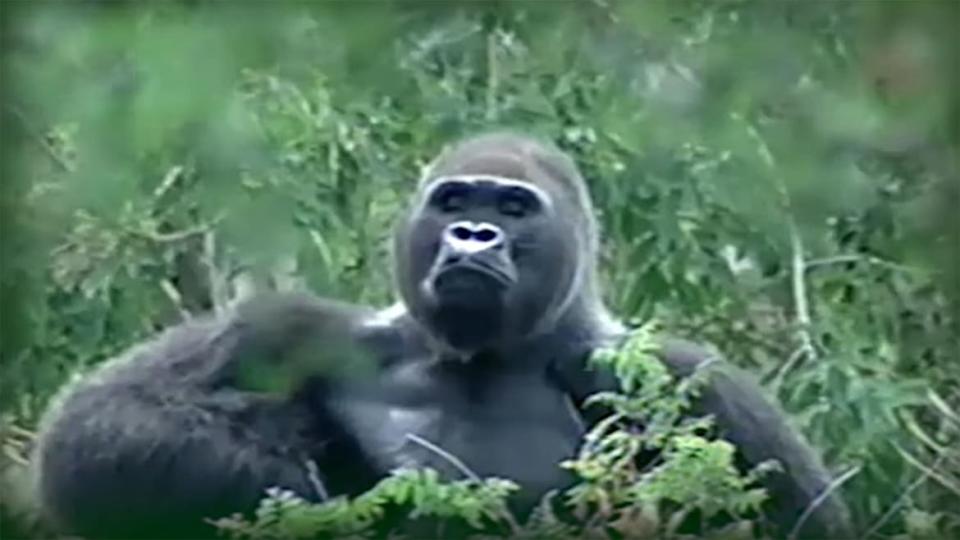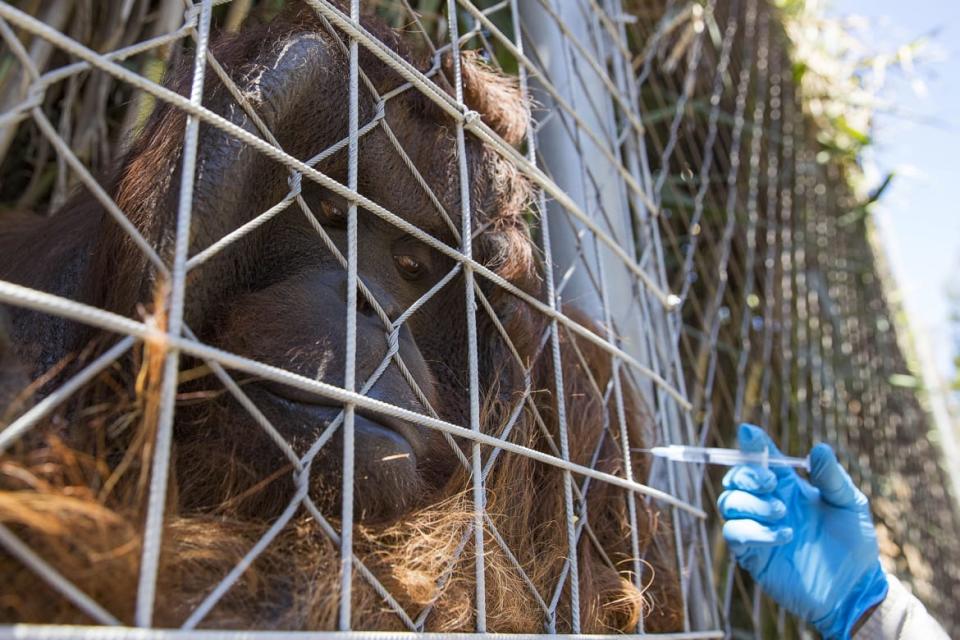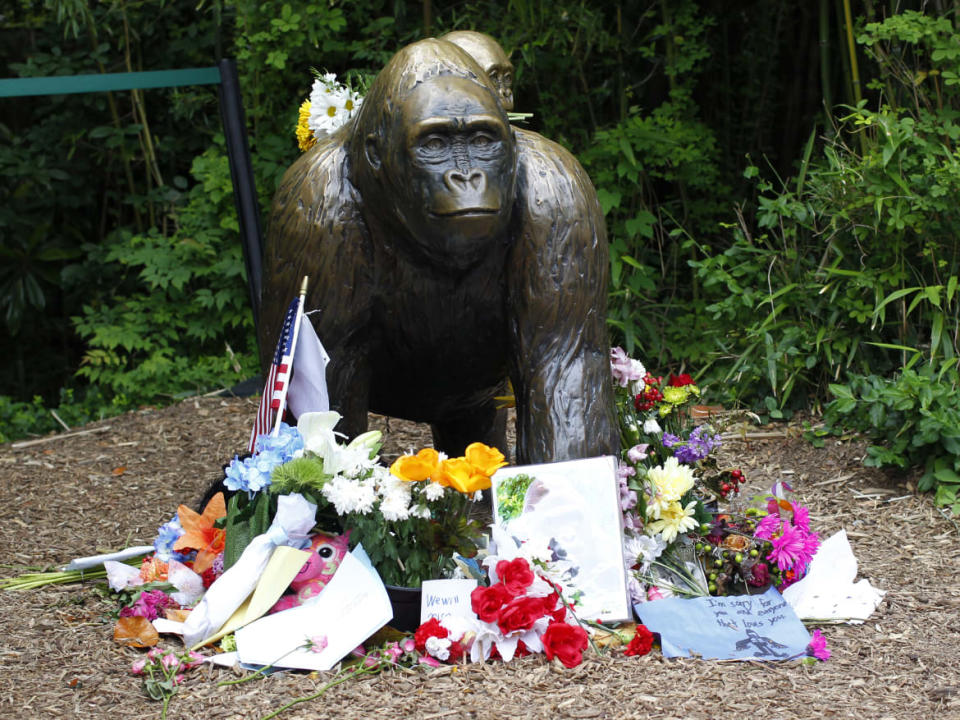COVID Truthers’ New Martyr Is a Gorilla Mom Named Martha

After spending over a year attempting to implicate overwhelmingly safe and effective COVID-19 vaccines in as many deaths and injuries as possible, you’d think pandemic truthers would be running low on novel fearmongering narratives to peddle. But earlier this month, influencers in this space identified a totally new and unexpected alleged vaccine victim: a gorilla.
Until last month, Martha, a 32-year-old western lowland gorilla, lived at the Gladys Porter Zoo in Brownsville, Texas. According to a slew of COVID truther articles, newsletters, and social media posts, she was a happy, healthy mother—until zoo staff senselessly injected her with a COVID-19 vaccine. Then she died suddenly and unexpectedly of multiple organ failure, stemming from an undetected fibrosing heart disease. Which, to anti-vax eyes, was clearly caused by the jab. (It wasn’t).
This is a compelling narrative for many in the truther crowd. It seems to signal a new level or type of so-called COVID tyranny, and involves a uniquely tragic victim—a sweet, endangered animal. Yet for all its novel elements, this tale still appears to be grounded in long-standing truther tropes about the risks that vaccines supposedly—but in fact do not—pose to heart health and current or expectant mothers in particular. Accordingly, it’s triggered a fresh round of digital outrage as it’s spread across fringe corners of social media.
“TOTALLY UNNECESSARY TO GIVE THE ANIMALS THE VACCINE FOR COVID. FAUCI’S NA?I [Nazi] SCIENCE KILL HER,” one account on Twitter blared in a tweet posted on May 7. The tweet ultimately linked back to a conspiratorial Substack newsletter post about Martha’s death that has circulated widely in vaccine-skeptic circles.
“Zoo killed their Gorilla with the COVID Jab. Same death coming to jabbed humanity near you,” another account tweeted on May 5, linking out to a far-right news site’s coverage of her death. “Not surprising as the autopsy revealed the same result from mRNA test animals: ‘multiple organ abnormalities’ ‘fibrosing heart disease’ ‘renal failure.’”
“So NOW will they care since it was a protected species animal vs. the many humans who have died from vaxes?” another account tweeted on the same day, linking out to the same Substack post. (It’s unclear what vague, conspiratorial “they” the poster meant.)
There’s just one problem with this tale: It’s total bullshit. In fact, Martha was not even vaccinated.
COVID Truthers Have Found a New ‘Pandemic’ to Freak Out About
Martha the gorilla died on April 19. In the days before her death, she was receiving treatment for a urinary tract infection, but seemed fine otherwise, according to zookeepers who monitor the Gladys Porter Zoo’s animals several times every day. On April 27, the zoo released an official statement from their senior veterinarian, Thomas de Maar, explaining that, upon examination of Martha’s body, he and his colleagues had found “multiple organ abnormalities, which, in turn, created a life-ending cascade. The cascade began with fibrosing heart disease, which led to renal failure.”
But just because Martha’s death was sudden and unexpected doesn’t mean that it was totally inexplicable, or even unusual. Notably, some truthers have focused on Martha’s age, likely because they are obsessed with the idea that COVID-19 vaccines are causing an unprecedented epidemic of heart disease among young, healthy humans, and 32 sounds quite young. But Martha Robbins, a leading gorilla researcher and conservationist, told The Daily Beast that, for a gorilla, Martha wasn’t young at all. In the wild, most gorillas die between the ages of 30 and 40. Some make it over 50 in zoos, but only with a level of medical monitoring and intervention that they wouldn’t get in nature.

Martha’s father, Lamydoc, pictured, died at Gladys Porter Zoo at approximately 60 years of age.
Several experts on great ape health also told The Daily Beast that the heart conditions, including the one Martha had, are actually incredibly common among gorillas in zoos. Veterinarians have been aware of this phenomenon for decades; many actually banded together to form the Great Ape Heart Project, an organization dedicated to studying the issue, back in 2010.
However, heart disease can be hard to identify even when you’re monitoring an ape every day, as de Maar, the senior vet at the zoo, told The Daily Beast.
“Wild animals will do everything they can to hide symptoms of disease until the end, because in the wild, if you start looking in poor health, you are potentially going to be somebody’s lunch, or your own group will start picking on you because that’s their social dynamic,” he explained. “So not only can my patients not talk to me, they are doing their utmost to hide disease symptoms.”
A heart condition will often show up during a full health exam, he added. But those procedures are so involved that they usually have to anesthetize the animals under examination—a process that involves its own safety risks. So they only do those check-ups every few years. Martha’s last big work-up occurred about three years ago, de Maar recalled. There was no sign of heart disease at the time. But a few years is plenty of time for an aging gorilla to develop a common condition.
News of Martha’s death didn’t appear to attract much attention outside of the local community and a few conservation circles—until May 1, when a COVID vaccine skeptic tweeted a mainstream article about it to her over 23,000 followers. The tweet highlighted mention of a heart condition leading to organ failure, but offered none of this vital context about heart disease in great apes in general. No reputable coverage of Martha’s death said anything about COVID or vaccines. But right after posting that story, this individual tweeted a link to an article in the same outlet, published in July 2021, about the zoo’s intention to start vaccinating its animals. The zoo did act on that intention—but it only started vaccinating its gorillas against COVID-19 weeks after Martha’s death. This tweet did not offer that context.
In fact, the poster didn’t make any commentary in that second tweet. But the pointed intent of the just asking questions juxtaposition was glaringly clear.
The vaccine skeptic in question did not reply to a request for comment for this story, so it’s hard to tell how she or her circle heard about Martha and decided to imply a possible connection between her death and the zoo's vaccination plans. But pandemic truthers have a well-established habit of hunting for deaths they can attribute to the COVID-19 vaccines. “Lately, we have noticed comments of, ‘Were they vaxxed?’ whenever any death attracts attention on social media,” René Najera, an epidemiologist who monitors anti-vax communities, told The Daily Beast.
David Gorski, a doctor who’s followed and reported on anti-vax communities for decades, added that these folks are often especially quick to jump on deaths described as unexpected or sudden, and bend over backwards to insist that vaccines must be to blame. “If you think vaccines are so horrifically harmful, it’s very easy to let that cognitive bias lead to you blaming deaths, and other harms, on vaccines, even when the link is as tenuous as it can be,” he told The Daily Beast.

A Bornean orangutan named Sandai receives an experimental dose of a vaccine against COVID-19 made by the Zoetis veterinary laboratory, at the Buin Zoo in Buin, Chile, on Jan. 3, 2022.
“For anti-vaxxers, it’s always all about the vaccines,” added Dorit Reiss, a public-health law expert and active anti-vax watcher. “They’re always looking for bad outcomes they can blame on them.”
Usually, anti-vaxxers focus on alleged human victims. But there’s always been a thread of the anti-vax world that’s stoked fears about the effects of vaccines on animals. Typically, Gorski explained, anti-vaxxers take outlier reports about adverse reactions among dogs, cats, and other companion animals to veterinary vaccines, and spin them into tales of extreme, pervasive injuries and illnesses. “Often, these claims are linked to conspiracy theories about vets making up a need for vaccines to keep patients coming to their practices,” he added. “Kennels and dog daycares are [supposedly] in on the conspiracy, by requiring pets be up to date on their vaccinations.”
Over the last year especially, COVID truthers specifically have honed in on animal horror stories to stoke mistrust and anger towards doctors, researchers, and government officials.
Notably, last spring, a story made the rounds of the truther web, claiming all of the animals injected with COVID-19 vaccines during trials died months later from cardiac failure, immune disorders, sepsis, or other dire conditions. (This has been definitively debunked.) Over the last few months, truther accounts on social media have hyped up legitimately dreadful stories about China’s decision to kill the pets of COVID-quarantined people—and cull hamsters following an outbreak among them—as supposed proof of the monstrosity of pandemic control measures overall. And consistently over the last year, COVID truthers have insisted that “they” are gearing up to max-vaccinate every animal as part of a wider effort to destabilize the world via the pandemic.
“They are going to come after your animals next to destroy connections humans desperately need,” a prominent anti-vaxxer with almost 153,000 followers on Telegram wrote last spring.
“They’re coming after our pets soon with their poison jabs,” a conspiracy Telegram channel with over 28,000 followers wrote earlier this year. “More vax sales, more money for the pharma… more deaths.”
Zoos specifically came onto truthers’ radar in March 2021, when the San Diego Zoo announced that it’d used an experimental veterinary COVID-19 vaccine on nine apes. Over the next few months, dozens of other zoos expressed their interest in securing doses of that vaccine for their animals, too. As soon as they heard about these plans, many truthers insisted animal deaths were imminent.
“Man what the fuck they’re killing poor zoo animals with these toxic COVID ‘vaccines,’” a conspiratorial Telegram account with over 15,000 followers lamented, linking to a story about a regional zoo’s intention to obtain the vaccine and start administering it to their animals.
Truthers have cast the decision to vaccinate zoo animals against COVID-19 as inane, and likely sinister. Granted, none of them can seem to agree what the evil motive might be, but speculation has been wide-ranging. “They are giving the jab to all the big game animals even at the zoos so when they starve us we can’t raid the zoos,” one conspiratorial Telegram channel argued last summer. “I am being serious!”
But the San Diego Zoo’s decision to vaccinate its animals was the direct result of an outbreak of COVID-19 in January 2021 among the gorillas in its Safari Park. COVID spread among the gorilla communities in two other zoos last year as well. According to federal records, to date, 21 gorillas in American zoos have tested positive for COVID-19. These outbreaks didn’t come as a surprise, as we’ve known since early 2020 that some animals can catch COVID-19, and we’d already seen outbreaks among other zoo animal populations as early as April of that year.
Although most cases of COVID-19 among zoo animals have been mild to date, the pandemic has reportedly killed a few big cats in the United States. And gorillas especially are notoriously susceptible to human respiratory conditions. Although zoos have taken pains to limit exposure and provide solid care when their apes do get infected, there are well-documented and supported reasons to fear that an outbreak could lead to deaths, according to several experts on primate health The Daily Beast spoke to—or long COVID, which vets don’t yet know how to handle in animals, and fear could have unexpected effects.
Animal-health companies have developed safe and effective vaccines for several other strains of coronavirus that had huge impacts on livestock and pets in the past. So when researchers first heard about COVID-19 spreading to animals in early 2020, they spun up production on new vaccines using by now tried-and-true approaches. One of these companies, Zoetis, ultimately produced a vaccine that doesn’t use a weakened live virus, or mRNA; instead, it uses a synthetic version of the COVID-19 protein spike, and an adjunct to stimulate an immune system response.
Most zoos have active vaccination programs. De Maar, the senior vet at the Gladys Porter Zoo where Martha lived, noted that all of their mammals get rabies vaccinations because they’re in bat country—and thus at high risk of rabies infections. All of their primates get regular tetanus vaccinations. And all of their gorillas are vaccinated for a host of human diseases, including measles, mumps, rubella, diphtheria, pertussis, and polio.

Outside the Cincinnati Zoo Gorilla World exhibit days after officials were forced to kill Harambe, a 17-year-old Western lowland silverback gorilla in 2016.
All the vets The Daily Beast spoke to for this story said they’d rarely seen an adverse reaction to a vaccine among animals—and those they did see were usually the standard mild symptoms you’d observe in humans, like soreness around the site of the shot for a day or so. And while the Zoetis vaccine was (and is) still considered experimental, initial tests showed no notable adverse effects. Weighing precedent, evidence, and the risks of COVID-19 to key species, zoos overwhelmingly determined that it made sense to try to get their hands on the Zoetis vaccine and start administering it to their at-risk animals.
“In fact, not doing so could be viewed as highly negligent,” given zoos’ responsibility for the protection of their animal charges, noted Jürgen Richt, an expert on infectious disease in animals and the development and use of vaccines to control them at Kansas State University.
According to Christina Lood of Zoetis, the USDA—which oversees animal health in zoos—as well as local veterinary authorities approved the experimental administration of their vaccine. The agency also made the company responsible for regularly reporting safety data, and sending reports of any notable adverse effects within three days. A USDA representative told The Daily Beast that this approval is granted “on a case-by-case basis for certain zoo animals, based on consultations with the vaccine companies and the USDA’s Center for Veterinary Biologics.” To date, Zoetis claims that none of the zoos using their vaccine have reported any major adverse reactions. This claim aligns with, and reinforces, animal health experts’ initial judgments that the vaccine is overwhelmingly safe. Current findings also suggest that it is highly effective at stimulating immune protection.
But while demand for the Zoetis vaccine skyrocketed after the San Diego Zoo got ahold of it, and though the vaccine manufacturer promised last summer that they would donate doses to zoos and sanctuaries across the nation, rollout has apparently been relatively slow.
De Maar explained that, while he applied for access to the vaccine last summer, as local papers reported, the zoo did not get their first batch until April. Thanks to logistical hurdles, they were only able to start vaccinating their gorillas in the first week of May—several weeks after Martha died. So far, they’ve jabbed two.
None of this information shows up in truther coverage of Martha’s death. Instead, after the initial tweet juxtaposing news of her passing with a report about the zoo’s interest in vaccinating its animals against COVID-19, truther figures elaborated on that poster’s subtle-yet-clear insinuations with wild conjecture.
On May 2, a just-asking-questions vaccine skeptic asserted in another Substack post that Martha was in fact tragically young, as some zoo gorillas live until 50—and her father, Lamydoc, died at age 60 in February. This skeptic further speculated that maybe the vaccine killed Lamydoc too. (De Maar explained that he was euthanized, to address the pain and deteriorating quality of life he was suffering as a result of dementia, among other health conditions.) Also that day, a far-right blog with a history of spreading misinformation labeled Martha a “fully vaccinated gorilla.” Its story on Martha’s death also included a graphic of a gorilla overlaid with text reading “Vaccine Harambe,” which is now circulating online.
Another western lowland gorilla, Harambe spent most of his life at the Gladys Porter Zoo before being transferred to the Cincinnati Zoo, where staff shot and killed him in 2016 after he grabbed a toddler who fell into his enclosure. He quickly became a touchstone of digital culture—and the subject of a series of performatively overwrought mourning memes.
Neither the individual behind that Substack nor the owner of the blog in question replied to requests for comment on their claims and sourcing.
These individuals’ rush to pin Martha’s death on a vaccine she didn’t receive is particularly rich in light of the fact that, back in November, a handful of anti-vaxxers made the same insinuations about three giraffes at the Dallas Zoo who’d all died within a month of each other. Then their story rapidly fell apart when it became clear none of the animals were vaccinated. But instead of interrogating posts and articles about Martha’s death in the wake of that misfire, COVID truthers have appeared to embrace them as definite truth, repeating and further expanding on their claims in blog, social-media, and newsletter posts.
This, experts on anti-vax rhetoric told The Daily Beast, is par for the course in a world that cares more about how it can shoehorn evocative stories into its own narratives of danger and doom than it does about verifiable facts. In fact, Gorski predicted that anti-vaxxers will reject all of the information in this article as part of a cover-up, hiding the clear truth of Martha’s sudden death.
Truther influencers certainly have been priming their audiences for this sort of reaction. Notably, last year, many pandemic skeptic Telegram channels rejected news about COVID-19 outbreaks among animals as blatant propaganda, spread so that people would unquestioningly accept the clearly senseless vaccination of animals. Earlier this year, after one zoo announced its intent to vaccinate its animals, a conspiratorial Telegram channel with over 27,000 subscribers stressed that “we all know the moment an animal unfortunately dies they will blame everything but the jab.”
And one of the Substack posts repeating spurious claims about Martha’s death ran the following line as part of its coverage: “The zoo, of course, is not confessing. But everything is painfully obvious.”
Granted, anti-vax experts doubt truthers will put much more effort into spreading Martha's story, or trying to find others like it. Deaths in zoos are just too rare to generate the same scope and scale of outrage human vaccine-victim stories do. And while animals make for good blameless victims of supposed biopharma conspiracies and cruelty, they can’t engage in anti-vax advocacy like humans can.
But the move to rope Martha, a non-human, into the scrum of so-called vaccine victim news and outrage, truth and detail be damned, speaks to an overarching trend. That is, an effort by anti-vaxxers to widen their nets, in order to keep the bogus sense of an escalating threat they thrive on alive.
“People are looking for anything to justify their beliefs,” Jonathan Berman, a medical researcher who monitors anti-vax communities, told The Daily Beast. “It doesn’t matter what it is.”
Get the Daily Beast's biggest scoops and scandals delivered right to your inbox. Sign up now.
Stay informed and gain unlimited access to the Daily Beast's unmatched reporting. Subscribe now.

